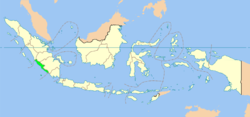Bengkulu Province
| Bengkulu | |||||||||
|---|---|---|---|---|---|---|---|---|---|
| Province | |||||||||
From top, left to right : Lake Dendam Tak Sudah, Bengkulu Traditional Dance, Grand Mosque of Curup, Rafflesia arnoldi, Soekarno's house while in exile in Bengkulu, Lake Dusun Besar, Thomas Parr Monument
|
|||||||||
|
|||||||||
| Nickname(s): Bumi Rafflesia Land of Rafflesia |
|||||||||
| Motto: Sekundang setungguan seio sekato (Malay) (Any hard jobs would be easier if it is done by teamwork) |
|||||||||
 Location of Bengkulu (marked in light green) in Indonesia |
|||||||||
 |
|||||||||
| Country |
|
||||||||
| Established | 18 November 1968 | ||||||||
| Capital and Largest City |
|
||||||||
| Government | |||||||||
| • Body | Bengkulu Regional Government | ||||||||
| • Governor | Dr. H. Ridwan Mukti, M.H | ||||||||
| • Vice Governor | Dr. H. Rohidin Mersyah, M.M | ||||||||
| Area | |||||||||
| • Total | 19,919.33 km2 (7,690.90 sq mi) | ||||||||
| Area rank | 24th | ||||||||
| Population (2014 Estimate) | |||||||||
| • Total | 1,828,291 | ||||||||
| • Rank | 26th | ||||||||
| • Density | 92/km2 (240/sq mi) | ||||||||
| Demonym(s) | Bengkulunese Warga Bengkulu (id) |
||||||||
| Demographics | |||||||||
| • Ethnic groups | Rejang (60,4%), Javanese (22,3%), Serawai (17,9%), Lembak (4,9%), Pasemah (4,4%), Minangkabau (4,3%), Malay (3,6%), Sundanese (3%), Batak (2%) | ||||||||
| • Religion | Islam 95,27%, Christianity 3,59%, Hindu 0,73%, Buddhism 0,41% | ||||||||
| • Languages | Indonesian (official language), Rejangese, Javanese language, Serawai, Lembak language, etc. | ||||||||
| Time zone | Indonesia Western Time (UTC+7) | ||||||||
| Area code(s) | 0732 (Kepahiang, Curup or Rejang Lebong), 0736 (Bengkulu, Central Bengkulu, Seluma), 0737 (Muko-Muko, North Bengkulu), 0738 (Lebong), 0739 (Kaur, South Bengkulu) | ||||||||
| Vehicle registration | BD | ||||||||
| HDI |
|
||||||||
| HDI rank | 11th (2013) | ||||||||
| Largest city by area | Bengkulu - 144.52 square kilometres (55.80 sq mi) | ||||||||
| Largest city by population | Bengkulu - (308,756 - 2010) | ||||||||
| Largest regency by area | North Bengkulu Regency - 5,548.54 square kilometres (2,142.30 sq mi) | ||||||||
| Largest regency by population | North Bengkulu Regency - (256,358 - 2010) | ||||||||
| Website | Government official site | ||||||||
Bengkulu, historically known as Bencoolen or British Bencoolen, is one of the Provinces of Indonesia and is located in the southwest coast of Sumatra. It was formed on 18 November 1968 by separating out the former Bengkulu Residency area from South Sumatra (Sumatra Selatan) province under Law No. 9 of 1967 and was realized by Government Regulation No. 20 of 1968. Spread over 19,813 km2, it is bordered by the provinces of West Sumatra (Sumatra Barat) to the north, Jambi to the northeast, Lampung to the southeast, South Sumatra (Sumatra Selatan) to the east, and the India Ocean to the northwest, south, southwest, and west.
Bengkulu is the 25th largest province by area; it is divided into nine regencies and the separate city of Bengkulu, the capital and largest city. Bengkulu is also the 26th largest province by population in Indonesia. According to a release by Badan Pusat Statistik, it has the eleventh highest Human Development Index among the provinces, with a score about 0.744 in 2013. By 2014, the province positions 28th highest in gross domestic product and 20th highest in life expectancy, 70.35 years.
Bengkulu Province comprises not only land on southwest Sumatra, but also includes Mega Island and Enggano Island in the Indian Ocean. Bengkulu has 525 kilometres of coastline along the Indian Ocean on its western side, from Dusun Baru Pelokan in Muko-Muko Regency to Tebing Nasal in Kaur Regency. Bengkulu is home to many natural resources such as coal and gold, and has big and potential geothermal resources. In addition, it is less developed than other provinces in Sumatra.
The name "Bencoolen" is predicted to be taken from a name of the hill in Cullen, Scotland, Bin of Cullen. This naming is less accurate because it is not the nature of the Malays to call their area with the name of an unknown area, let alone the origin of the name was taken from Scotland that is located far away from Bengkulu.
Traditional sources mention that the Bengkulu or Bangkahulu derived from the word 'bangkai' and 'hulu' which means 'carcasses located in an upstream'. According to the story, there were once a war between small kingdoms in Bengkulu. awhich resulted in many casualties on both sides in the river streams in Bengkulu. These casualties soon became rotten corpses as they are not buried, lying in river streams. Then comes the name Bangkaihulu which gradually are pronounced Bangkahulu or Bengkulu. This naming is similar to the story of a war between the Majapahit Empire and the Pagaruyung Kingdom in Padang Sibusuk, an area once ruled by the Dharmasraya empire , which also tells that the name Padang Sibusuk is derived from war casualties rotting on the battlefield.
...
Wikipedia








